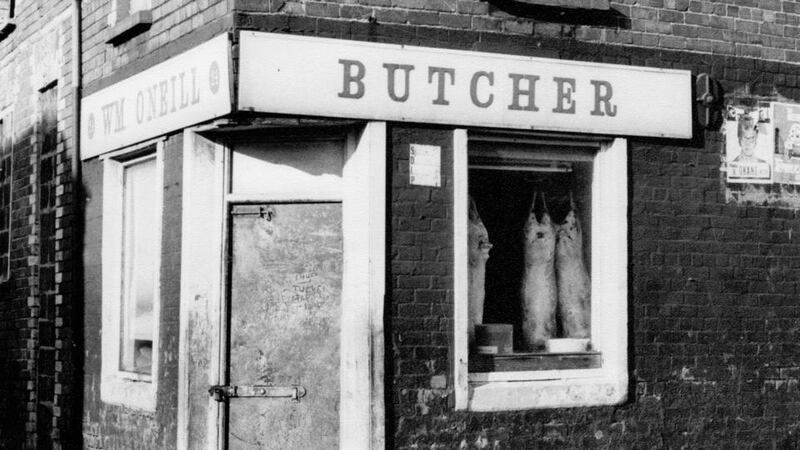
In his 1987 collection, The Irish for No, Ciarán Carson has a poem called Slate Street School in which some ubiquitous elements of a distant primary education are enumerated: "chalk dust and iced milk, the smell of watered ink". The poem then branches out into a different dimension, imagining an avenging archangel swooping over "mills and factories and barracks", landmarks and symbols of "the dark city of Belfast". Born and brought up not far from Slate Street off the Falls Road, Carson attended the school in the 1950s; a few years ahead of him was another pupil destined to preserve and pinpoint the character of his home ground. This was Vincent Dargan, street photographer and aficionado of cobblestones and camaraderie.
The Dargan images assembled in this book are taken from a vast photographic archive held at Queen’s University Belfast. They date from the late 1960s to the mid or late 1970s, and show a succession of streets, shops, houses, factories and so on, all on the verge of obliteration. It’s all about to be swept away in a frenzy of redevelopment. Worse will follow (such as Divis Flats). Reinvention, or regeneration, has fallen drastically short of whatever well-meaning objective engendered it. The new Falls is, if anything, more lurid and dispirited than the old Falls. (This is true, of course, of much inner-city refurbishment, not just Belfast’s.)
Actually, Dargan’s title is something of a misnomer, as the book homes in on just a tiny section of the Falls, the portion known vernacularly as the Lower Wack, adjacent to the Pound Loney (the oldest part of the district), and surrounded by streets inappropriately named for Turkish rulers and battles: Sultan, Plevna, Balaklava.


The Lower Wack is not the whole of the Falls, indeed, but it distills a certain local vigour and indomitability, which makes it representative. Dargan approaches his subjects with a kind of deadpan accuracy and alertness. There's a powerful sense of communal felicity about his images – an important role allotted to every individual, and everyone valued for his or her contribution to local life. We note, for instance, the diminutive dressmaker who could fashion a boy's suit out of an old overcoat, the ragmen and coalmen and breadservers and pawnbrokers, and the man on a bicycle delivering a copy of the Belfast Telegraph to every household. The horse-and-cart, lamp-post-swinging, corner-shop aspect of the Falls was already obsolete by the time these black-and-white photographs were taken, but the last vestiges of a bygone world can still be glimpsed among the pointers to a fragmented future.
The Falls had no sooner relinquished its pre-Troubles obscurity than it was earmarked for demolition. Alongside the lived-in houses are those with bricked-up windows; hastily assembled barricades and British soldiers on foot patrol lend an unprecedented ominousness to the old red-brick streets. A boy on a bicycle rides with a cheery smile past an overturned burnt-out car. St Peter’s Pro-Cathedral, with its twin spires, is shown presiding over mutilated terraces and acres of waste ground strewn with rubble where wholesale wreckage has been carried out. An impending bleakness and ugliness prevail.
The photographer’s emphasis, on the whole, is more cheerfully placed, as befits an enterprise directed more towards celebration than social criticism. No shawlies or flagrant poverty; no looming mills. You can almost hear the din and clatter of the street traders pictured here, the children’s rumbustious games, urchins innocently up to no good, neighbours carrying out kitchen chairs to sit and gossip in the sun. A decent old couple, arm in arm, take a stroll along exceptionally clean and empty Servia Street.
Many of Dargan's photographs are redolent of a wry, dry, Falls Road humour and repartee. He has caught nearly all of his subjects in a good mood – or, at least, putting on a good show for the camera. What you notice – what everyone susceptible to nostalgia notices about old photographs – is the absence of litter in the pre-1970s streets, the scrubbed doorsteps, lace curtains, flowerpots perched insouciantly on window ledges. You might feel you've strayed into My Aunt Jane territory here, jaunty and pungent.
Politics never far away It is the Falls Road, however, and social and political factors are never too far away. Dargan has recorded Marian and Corpus Christi processions, Holy Communion dresses, the whole religious ethos, and, in one or two instances, the effects of bombing campaigns just getting under way. Disaffection is gaining a lethal outlet – and a subversive orientation is implicit in the republican slogans and the 1971 demonstrations against internment that have caught the photographer's eye.
He's recording history as it happens, with attentiveness and efficiency – and making us aware of a lost, indigenous, proletarian charm. The wiped-out, displaced or reconfigured community once had its own spark and integrity. Here's Carson again, in Question Time, going down the Falls in his imagination, "Past vanished public houses . . . past drapers, bakers, fishmongers, boot shops, chemists, pawnshops, picture houses, confectioners and churches, all swallowed in the maw of time and trouble".
Books like Dargan’s, with its succinct running commentary, its abundance of information to absorb and assess, make a complementary way of recapturing the past, telling – or showing – it like it was.









